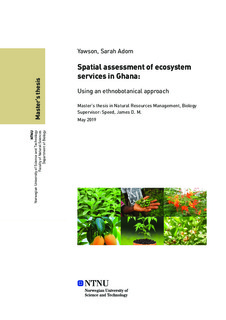| dc.description.abstract | Ecosystem services support countless livelihoods worldwide. These include the provisioning of medicines, food, fuelwood, livestock fodder, building materials and cultural artefacts that have been documented in ethnobotanical studies. In Ghana, most indigenous communities rely on traditional uses of plants although there are still untapped potentials of plants. Knowledge of the distribution of plants of Ghana is still unclear due to a lack of studies. The latter has resulted in limited records in investigating the distribution of ecosystem services in Ghana. Researchers have provided an appropriate way of evaluating the distribution of plant species with the application of species distribution models (SDMs) to remedy the situation. This project aimed to integrate SDMs and ethnobotany to map a spatial distribution of plant-derived ecosystem services in relation to annual precipitation, temperature, human population and land cover in Ghana. A review of ethnobotanical studies of plants used by indigenous people in Ghana was conducted to compile and categorise ecosystem services derived from plants. A total of 398 species of plants were identified as providing ecosystem services. The identified plant species encompassed healthcare (72%), agriculture (8%), energy (4%), food and nutrition (5%), construction (3.4%), culture (2.5%), social (4.6%) and water purification (0.25%) ecosystem services. A further 16 groups were derived from the healthcare category, reflecting fields of medicine. Records of the occurrence of plants were obtained from GBIF and analysed spatially. Detailed species distribution models of the 8 ecosystem service categories and 16 groups within the health care category were provided with Maximum Entropy modelling approach using data from the human population, land cover, annual precipitation, and temperature seasonality. The model performance was best for ecosystem services with the fewest number of species. Modelling the ecosystem services and groups within health care in general, resulted in poor SDMs. However, analyses of individual species within these ecosystem services and healthcare groups improved the models and further allowed for the assessment of variables related to key species. Assessment of variable contributions pointed out land cover and temperature as the most important to the ecosystem services distribution. This study provides the basis that models with multiple species and within a large range of habitat requirement do not work well. Temperature and land cover are important in predicting the spatial distribution of plant-derived ecosystem services. Additionally, SDMs are appropriate in prioritising target species in Ghana for specific ecosystem services. | |
